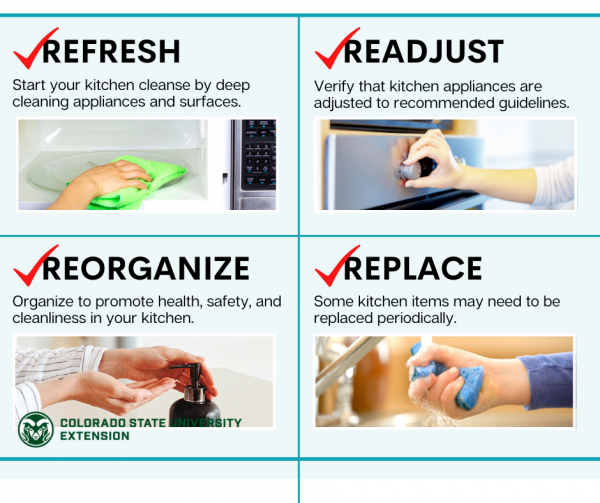Food Safety – Kitchen Cleanse
Content Source: Food Smart Colorado (CSU Extension)
Check out these four steps for a thorough kitchen cleanse that will reduced the risk of foodborne illness, prevent unwanted pests in your home, maximize the performance of your appliances, and protect the shelf life of your food!

REFRESH
Start by deep cleaning the appliances and surfaces in your kitchen. No need for harsh chemicals – gentle soaps, vinegar, and baking soda will do the job!
- Refrigerator: Wipe down all shelves, door handles, and gaskets to prefent cross-contamination from foods in your fridge. Remove the drawers, wash them in warm water and dish soap, rinse, and dry them. Don’t forget to clean the water and/or ice dispenser!
- Oven: Cleaning your oven will improve its efficiency and can prevent fires! Using a solution of one part vinegar, two parts water, scrub your oven with a soft-bristled brush to remove residue (be sure to clean both the inside and the door of the oven).
- Dishwasher: Regularly use a damp cloth to remove spills and residue. Don’t forget to get the top and sides! Be sure to check the drain area periodically to remove any blockage.
- Sink: Wash the handles, faucet, and basin of the sink. Sprinkle one tablespoon of baking soda and half a cup of vinegar in the disposal and let it sit for 15-20 minutes. Rinse with hot water. Wash any splash guards or drain stoppers.
- Countertops: Wash your countertops with a cleaner that is appropriate for the surface, and use a scrub brush for tiled or hard to reach places. Drying your counter with a clean towel can help prevent bacteria re-growth.
READJUST
Make sure your kitchen appliances are adjust correctly for food safety and optimal energy efficiency.
- Refrigerator and Freezer: Set your refridgerator to 40 degrees Farenheit or below to keep food fresh, prolong shelf-life, and prevent bacteria growth. Freezers should be 0 degrees Farenheit. If you do not have a temperature indicator, use a refrigerator thermometer.
- Oven: Use an oven thermometer to check that your oven is reaching the correct temperature.
- Dishwasher: Using an extra hot cycle on heavy loads promotes cleanliness and helps destroy bacteria. Opting for a light wash option on pre-rinsed dishes can help with energy efficiency.
- Pantry: The ideal conditions for a pantry to ensure better shelf life for nonperishable items are dry, dark, and cool (between 50 degrees and 70 degrees Farenheit). Be sure to check for expiration dates and pest damage on stored foods.
REPLACE
Some common items in your kitchen need to be periodically replaced for food safety!
- Sponges: Sponges grow bacteria due to their moist surfaces, so they need to be replaced regularly.
- Cutting Boards: Bacteria can grow on cutting surfaces that have become warped, worn, or scratched, and that bacteria can be transferred to food. Make sure you are using smooth plastic or hard wood boards, and check them to see if they need to be replaced. Between uses, clean with hot water and dish soap OR clean them in the dishwasher (if appropriate for the type of board you are using).
- Ice Packs: Clean ice packs between each use and check for leaks to see if you need to replace them.
- Takeout Containers: Single-use containers should be recycled or disposed of, especially paperboard or styrofoam containers. Be sure to use food-grade conatiners for storing food and, when heating food, use microwafe safe containers.
REORGANIZE
Reorganizing your kitchen can help with the health and cleanliness!
- Shelf Liners: Removable and wipeable shelf liners makes cleaning up dust, crumbs, and spills easier and faster, especially under the sink, in cabinets, and in your pantry.
- Hand Washing: Make sure you have liquid hand soap and a clean, dry towel near the kitchen sink for good hand hygiene.
- Better Drying Solutions: To prevent moisture that will foster bacteria, make sure you have drying racks that will effectively dry dishes, as well as kitchen cloths and sponges.

0 Comments